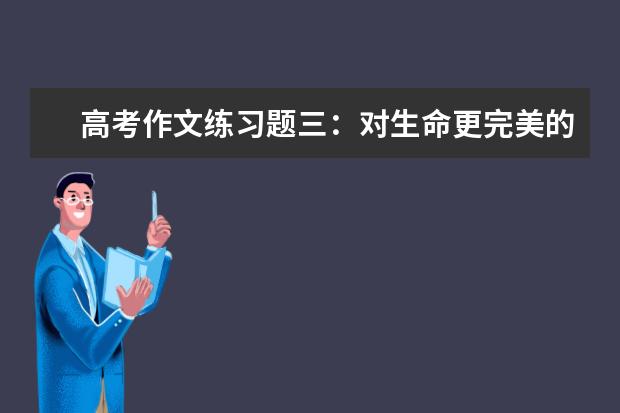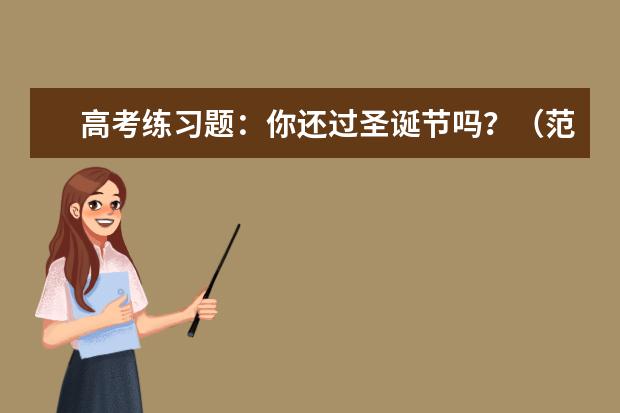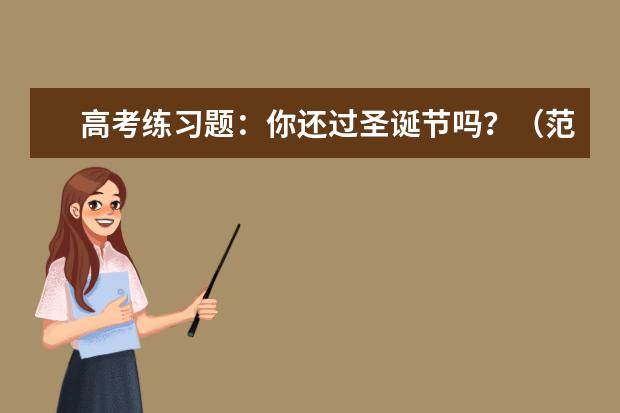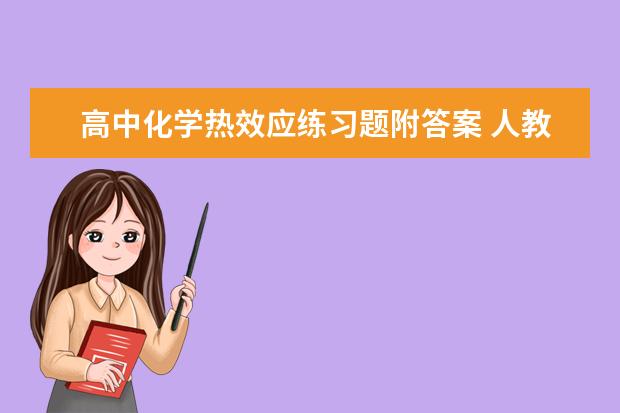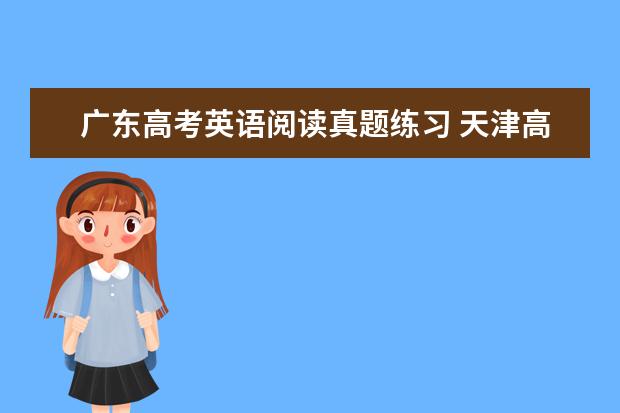
广东高考英语阅读真题练习
广东高考英语阅读真题练习
阅读理解是高考英语试卷中必考的题型,需要考生多做练习提高阅读理解能力。下面学习啦小编为大家带来广东高考英语阅读真题练习,欢迎各位同学练习。
广东高考英语阅读真题练习原文
It was a cold winter day.A woman drove up to the Rainbow Bridge tollbooth (收费站).“I'm paying for myself,and for the six cars behind me,”she said with a smile,handing over seven tickets.One after another,the next six drivers arriving at the tollbooth were informed,“Some lady up ahead already paid your fare.”
It turned out that the woman,Natalie Smith,had read something on a friend's refrigerator:“Practice random kindness and senseless acts of beauty.”The phrase impressed her so much that she copied it down.
Judy Foreman spotted the same phrase on a warehouse wall far away from home.When it stayed on her mind for days,she gave up and drove all the way back to copy it down.“I thought it was beautiful,”she said,explaining why she'd taken to writing it at the bottom of all her letters,“like a message from above.”Her husband,Frank,liked the phrase so much that he put it up on the classroom wall for his students,one of whom was the daughter of Alice Johnson,a local news reporter.Alice put it in the newspaper,admitting that though she liked it,she didn't know where it came from or what it really meant.
Two days later,Alice got a call from Anne Herbert,a woman living in Marin.It was in a restaurant that Anne wrote the phrase down on a piece of paper,after turning it around in her mind for days.
“Here's the idea,”Anne says.“Anything you think there should be more of,do it randomly.”Her fantasies include painting the classrooms of shabby schools,leaving hot meals on kitchen tables in the poor part of town,and giving money secretly to a proud old lady.Anne says,“Kindness_can_build_on_itself_as_much_as_violence_can.”
The acts of random kindness spread.If you were one of those drivers who found your fare paid,who knows what you might have been inspired to do for someone else later.Like all great events,kindness begins slowly,with every single act.Let it be yours!
广东高考英语阅读真题练习题目
1.Why did Natalie Smith pay for the six cars behind her?
A.She knew the car drivers well.
B.She wanted to show kindness.
C.She hoped to please others.
D.She had seven tickets.
解析 事实细节题。第一段说Natalie Smith为其后面的六辆车交费,是她因看到的“Practice random kindness and senseless acts of beauty”这句话给了她深刻印象,她是受这句话的启发,“想给他人施恩”,故选B。
答案 B
2.Judy Foreman copied down the phrase because she ________.
A.thought it was beautifully written
B.wanted to know what it really meant
C.decided to write it on a warehouse wall
D.wanted her husband to put it up in the classroom
解析 事实细节题。由第三段第三句“I thought it was beautiful,”she said,explaining why she'd taken to writing it at the bottom of all her letters可知,选A。
答案 A
3.Who came up with the phrase according to the passage?
A.Judy Foreman. B.Natalie Smith.
C.Alice Johnson. D.Anne Herbert.
解析 事实细节题。由第四段中的“It was in a restaurant that Anne wrote the phrase down on a piece of paper”可知,是Anne Herbert想出这句话来的。
答案 D
4.Which of the following statements is closest in meaning to the underlined sentence above?
A.Kindness and violence can change the world.
B.Kindness and violence can affect one's behavior.
C.Kindness and violence can reproduce themselves.
D.Kindness and violence can shape one's character.
解析 词义猜测题。本段中先是Anne Herbert解释她想出的那句话意为:你认为(生活中或世界上)应该多一些存在的事,那么你就随意去做这样的事。接着说她想象中的这类事包括“给破旧教室粉墙”“在穷人区的厨房里留下热饭”等善举。那么该段结尾的话“善举和暴力一样可以在它们自己的基础上建立起来”,可知“善举同暴力一样是可以自我繁衍的”,故选C。
答案 C
5.What can we infer from the last paragraph?
A.People should practice random kindness to those in need.
B.People who receive kindness are likely to offer it to others.
C.People should practice random kindness to strangers they meet.
D.People who receive kindness are likely to pay it back to the giver.
解析 推理判断题。由最后一段的第一和第二句可以推知:受到恩惠的人很可能会施惠于他人,将恩惠传播下去。
答案 B
天津高考英语阅读练习题附答案
天津高考英语阅读练习题附答案
阅读理解在高考英语中占有很大的分值,想要提高英语阅读的能力就要多做真题练习。下面学习啦小编为大家带来天津高考英语阅读练习题附答案,供考生阅读训练。
天津高考英语阅读练习题原文
People bury treasure to stop other people from taking it. They choose a quiet place, dig a deephole and bury the treasure in it. Then they make a map of where the treasure is or write downother clues(线索)that will help them or someone else to find it again.
In Britain a few years ago; a writer wrote about some treasure that he had buried. He put cluesin the story to help readers find it. Thousands of people hunted for the treasure. They dug holesall over Britain, hoping to find it.
One of the most popular adventure stories ever written is Robert Louis Stephenson'sTreasured Island, an exciting story about a young boy, Jim Hawkins, who is captured by piratesand later finds some buried treasure.
Then there is the true story about a man who had to travel overseas for a year. He did not trustbanks, so he buried his life savings in a park. Then he went away. On his return, he wentstraight to the park. But the park was no longer there. In its place there was a huge building.
And then there was the man who buried his savings, all in bank notes, in a waterproof(防水的)bag. When he dug it up years later, there was nothing left. Worms and insects had eaten thebag and everything in it.
And of course, these are stories about people who bury things and either forget where theyhave buried them or lose the map.
Although it is true that people sometimes lose their money because a bank fails, banks are stillthe safest place to keep our savings and treasures.
天津高考英语阅读练习题
1.People who bury treasure usually______________
A.do not trust banks
B.have a little money .
C.want to live in a quiet place.
D.expect to lose it
2.The writer in Britain________________
A.really had buried something.
B.started a nationwide treasure hunt.
C.had lost his treasure and wanted people to help him find it.
D.caused trouble because people dug holes everywhere.
3.Treasure Island_____________________
A.is a story about pirates.
B.is about the adventures of Jim Hawkins.
C.is the most popular story ever written
D.is a well-known fairy tale.
4.The man who buried his money in a park____________
A.thought his money was safer there than in a bank.
B.travelled on the sea for a year.
C.got his life savings back again.
D.stayed away longer than he expected.
5.From these stories we understand that______________
A.we cannot trust banks.
B.we should not trust anyone.
C.a waterproof bag is not proof against worms and insects.
D.insects eat anything.
天津高考英语阅读练习题答案
1.A
2.B
3.B
4.A
5.C
以上,就是天天高考网小编给大家带来的广东高考英语阅读真题练习 天津高考英语阅读练习题附答案全部内容,希望对大家有所帮助!
如果你需要图片压缩,天天高考小编推荐个不错的在线图片压缩网站:https://www.yasuotu.com/
如果你需要图片压缩,天天高考小编推荐个不错的在线图片压缩网站:https://www.yasuotu.com/
